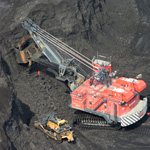Case Study - Dirty Oil Sands
Cooking oil out of tar sands creates a major environmental challenge

Canada's Alberta tar sands are the global focal point for the future of oil. A significant resource, the extraction process makes this oil to be considered by many as the world's dirtiest, most expensive, and dangerous fossil fuel. Water consumption during extractions and processing, water contamination, air pollution, and destruction of boreal forest are major concerns in a region that hosts North America's second largest watershed.
Tar sands impacts on people, climate and the environment - from Canada to Africa
By: Friends of the Earth (2011)
This fact sheet explains how much the global development of tar sands will magnify the climate crisis and damage the environment and development objectives. Tar Sands are a naturally occurring mixture of sand or clay, water and an extremely dense and viscous form of petroleum called bitumen. The process of converting tar sands into fuel releases three to five times the greenhouse gas emissions of conventional oil. The pollution, deforestation, and disturbance to wildlife associated with tar sands development threaten the additional livelihood and wellbeing of indigenous communities.

